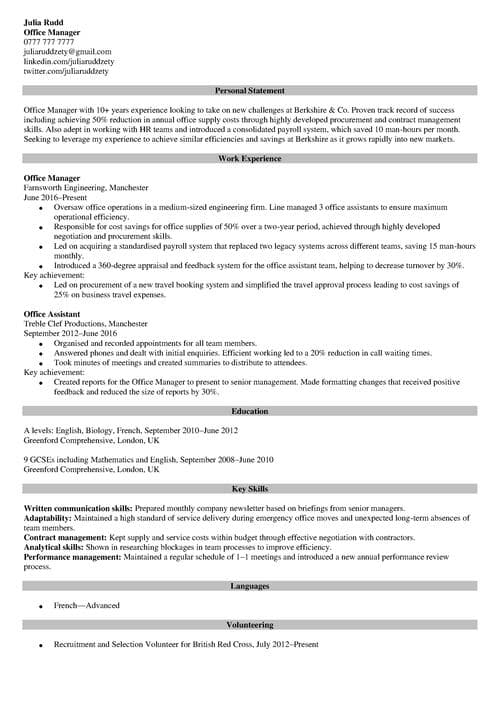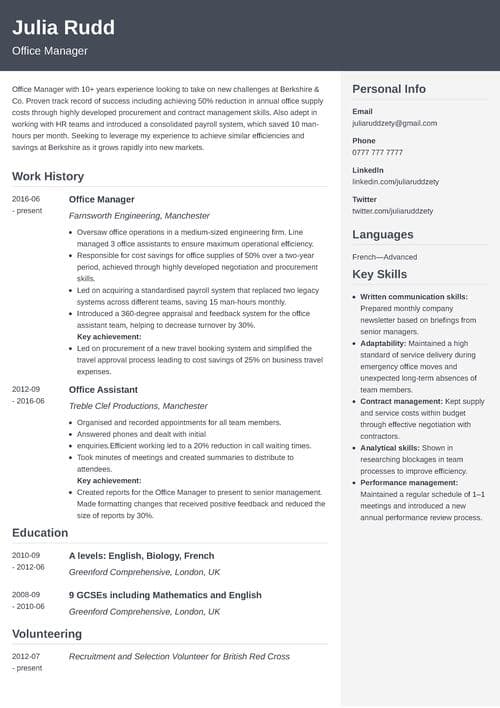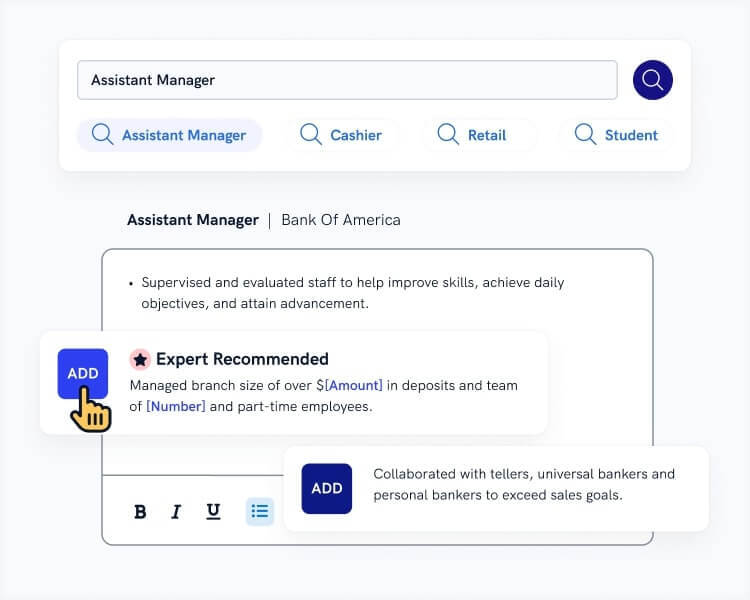How to Write a CV: Expert CV Writing Tips & Examples
Create your CV nowYou create your CV and click send. Then nothing, quieter than Brighton pier on a wet December afternoon. When every vacancy attracts dozens of applicants, recruiters only select the best. So, how to write a CV that’ll make you one of the happy few called to interview? Read on, and I'll show you how to make a good CV.
This guide will show you:
- A CV template better than 9 out of 10 other CVs.
- How to write a good CV that will land you more interviews.
- Tips and examples of how to write a CV that highlights your skills and achievements.
- How to make a CV work experience section to get any job you want.
Want to save time and have your CV ready in 5 minutes? Try our CV builder. It’s fast and easy to use. Plus, you’ll get ready-made content to add with one click. See 20+ CV templates and create your CV here.
Sample CV made with our builder—See more templates and create your CV here.
CV template
Julia Rudd
Office Manager
0777 777 7777
juliaruddzety@gmail.com
linkedin.com/juliaruddzety
twitter.com/juliaruddzety
Personal Statement
Office Manager with 10+ years experience looking to take on new challenges at Berkshire & Co. Proven track record of success, including achieving a 50% reduction in annual office supply costs through highly developed procurement and contract management skills. Also adept in working with HR teams and introduced a consolidated payroll system, which saved 10 man-hours per month. Seeking to leverage my experience to achieve similar efficiencies and savings at Berkshire as it grows rapidly into new markets.
Work Experience
Office Manager
Farnsworth Engineering, Manchester
June 2016–Present
- Oversaw office operations in a medium-sized engineering firm. Line managed 3 office assistants to ensure maximum operational efficiency.
- Responsible for cost savings for office supplies of 50% over a two-year period, achieved through highly developed negotiation and procurement skills.
- Led on acquiring a standardised payroll system that replaced two legacy systems across different teams, saving 15 man-hours monthly.
- Introduced a 360-degree appraisal and feedback system for the office assistant team, helping to decrease turnover by 30%.
Key achievement:
- Led on procurement of a new travel booking system and simplified the travel approval process leading to cost savings of 25% on business travel expenses.
Office Assistant
Treble Clef Productions, Manchester
September 2012–June 2016
- Organised and recorded appointments for all team members.
- Answered phones and dealt with initial enquiries. Efficient working led to a 20% reduction in call waiting times.
- Took minutes of meetings and created summaries to distribute to attendees.
Key achievement:
- Created reports for the Office Manager to present to senior management. Made formatting changes that received positive feedback and reduced the size of reports by 30%.
Education
A levels: English, Biology, French, September 2010–June 2012
Greenford Comprehensive, London, UK
9 GCSEs, including Mathematics and English, September 2008–June 2010
Greenford Comprehensive, London, UK
Key Skills
- Written communication skills: Prepared monthly company newsletter based on briefings from senior managers.
- Adaptability: Maintained a high standard of service delivery during emergency office moves and unexpected long-term absences of team members.
- Contract management: Kept supply and service costs within budget through effective negotiation with contractors.
- Analytical skills: Shown in researching blockages in team processes to improve efficiency.
- Performance management: Maintained a regular schedule of 1–1 meetings and introduced a new annual performance review process.
Languages
- French—Advanced
Volunteering
- Recruitment and Selection Volunteer for British Red Cross, July 2012–Present
Expert Curated Video Content
If you prefer watching, our Certified Professional CV Writer, Caio, will explain in detail how to write a CV!
What is a CV?
A CV is a document summarising your work history, education, professional skills, and qualifications. Optionally, a CV can also present your professional awards, accolades, memberships, and relevant hobbies. CV is an abbreviation for the Latin phrase “curriculum vitae,” which means “course of life.”
How to make a good CV?
So now you know what it is, let's get started on how to write a CV:
1. Use the right CV layout
What’s a CV layout? Simply put, layout covers how the document looks and includes the font size and type, colours, paragraph length, line spacing and so forth, etc. A good layout isn’t just visually attractive. It can be the deciding factor in whether you get the job.
Recruiters spend only six seconds on average looking at each CV. Get your CV design the layout wrong, and you’ve destroyed your first impression, along with any chance of getting an interview.
Here’s how to get your CV layout right:
- Select clear CV fonts: choose a modern, clean and readable CV font. For body text, go for 10 to 12-point font for the best balance between size and clarity. However, it’s better to err on the larger side to maximise readability. Increase the font size for section headings, making it 4 to 6 points bigger than your body text for emphasis.
- Adjust the CV margins: set your margins to one inch on all sides. You’re aiming to create a balance between content and white space. It makes your CV more readable and directs the eye to each separate section.
- Don’t forget about spacing: set your CV spacing to 1.15. Double-space after headings for emphasis.
- Pay attention to alignment: for the body of your CV, my advice is to always left-align only, with no justification—this is a standard formal business layout, and it reads better.
- Stick to the optimal CV length: how long should a CV be? When it comes to good CV examples, less is more. Stick to a one-page CV template if possible. If you have a longer work history, then two pages are fine, too. Three pages are only for more senior roles, particularly in management and technically complex industries.
- Choose the best file format: unless the job application says otherwise, go for PDF. It’s the best way of preserving your carefully arranged CV layout.
- Pick the right filename: use the right filename for your CV. At all costs, avoid “CV.pdf,” your CV file will be impossible to identify and get lost with the thousands of others who made this mistake while creating a CV. Avoid using initials or complex file names. Just use your name as an instant bit of personal branding.
Those are the basic CV layout rules. Let’s move on to the CV format.
Pro Tip: Keep formatting consistent throughout your CV. For example, always follow the same conventions when putting dates on your work experience section. That’s one of the best CV tips out there.
2. Choose the right CV format
In regard to writing a CV, formatting isn’t the same as CV layout. A CV format is a structure or framework to build your CV on. You still need to stick to the same layout rules, but different formats communicate your employment history, qualifications, and education in different ways.
There are two types of CV format in the UK: reverse-chronological and skills-based. I’ll cover each of them in turn.
The chronological CV is the most popular CV format and is used for the majority of jobs. It’s also easily readable by the ATS software that most larger employers use to scan job applications. ATS automates the first step in filtering out unsuitable applicants. You could be an excellent candidate, but if the ATS can’t read your CV, you’re finished before you’ve even started.
Reverse-chronological CV format focuses on your employment history and experience. You start with your most recent job and move back through time, listing your past jobs in order. Hence, reverse-chronological.
There’s one more format that can be useful for some job seekers Also called functional format, this format concentrates on your transferable skills, your core set of skills and abilities, rather than your employment history. A skills-based CV can work for people with gaps in their employment history, career changers, or to write a curriculum vitae for a job with no experience, such as a student CV.
But it’s a very risky format to use. My experience shows that recruiters tend to be suspicious of skills-based CV format and often assume you’re trying to pull a fast one. They hate them because the neatly laid out job history they’re used to is missing. That’s not to say the format is completely useless, but that’s a subject for another guide. For now, I’ll focus on reverse-chronological format CVs.
Enough theory, though, let’s get on with writing your CV.
You can save time creating your CV with pre-made templates. Read more: CV Design: 18 Beautiful Templates to Inspire You
3. Create a striking CV header
Your CV header is the section at the top that contains your name and contact details. It’s the first part of the page that gets read, so have to get it right.
When all is said and done, your CV is a sales pitch, and the product is you. So make sure your name is in bold. The header can be left or centre-aligned. But do ensure the body of your CV stays left aligned.
Include your job title if you’re currently working, then your contact number and a clickable email address. Listen to my advice and use a sensible personal email address, as studies have proven an informal email address has a negative impact on getting hired. Just stick with a combination of first name or initial and surname.
The best practice is to add value with clickable links to your LinkedIn profile and other appropriate online presence. An online portfolio is perfect if applicable to your career.
If in doubt, leave it out and stick with plain contact details.
CV example: header

Pro Tip: It’s perfectly okay not to include your residential address as it’s not one of the essential things to include in a CV. It just takes up space, and the hiring manager just might hold it against you if you’ve got a long commute.
4. Write a powerful CV personal statement
A personal statement for a CV, also known as a personal profile or CV profile, functions as the introduction to your CV. It’s a short paragraph designed to grab the recruiter’s attention and keep them reading.
A CV profile comes in two forms:
- CV summary: perfect for experienced candidates
- CV objective: ideal for those just entering the market or career changers
Before you start, read the job description. Your CV profile must be specifically tailored to each individual job advert. Don’t even think of copy-pasting the same personal statement for every CV you send.
While analysing the job advert, remember that your profile will be an advert itself—an advert for you.
Read more: Find out exactly how to make a perfect CV personal statement: The Best CV Personal Profile Examples & Writing Tips
5. List your work experience
We’ve covered the starter section, it’s time for the main course. Here’s how to make a CV work experience section:
- Begin with your job title: This should be the header for each entry in the section. Put this in bold or a larger font for emphasis and to make it easier for the reader to scan.
- Add the company’s name & city: Immediately follow this up with the company's name and workplace location. My layout tip here is to use italics for contrast.
- Specify the dates of employment: The month and year will suffice. No need to put exact dates.
- Present your responsibilities/achievements: 5–6 bullet points for each position, made relevant to the job you’re applying for.
- Pick the best keywords: Just as with your personal statement, glean keywords from the job description and include them in your experience section for a tailored curriculum vitae.
What comes next? Well, let’s say just ignore Pink Floyd. You do need an education, and here’s how to make a CV education section.
Pop your CV into different templates to see how it looks. Read more here: 20+ Free CV Templates to Download Now
6. Include education in your CV
Regardless of where you are in your career, you need to know how to write a CV education section. However, the stage of the career will dictate how this section should be structured.
If you’ve got little or no professional experience, then change the order of your CV and put your education section before your work experience section. Otherwise, leave your education section immediately following your work history.
Find out all the details you should know about how to make a CV education section in our in-depth guide: How to Include Education on Your CV?
Making a CV with our builder is incredibly simple. Follow our step-by-step guide, use ready-made content tailored to your job and have a CV ready in minutes.
When you’re done, Zety’s CV builder will score your CV and tell you exactly how to make it better.
7. Utilise professional qualifications in your CV
Professional certifications prove your qualities and can make you stand out from the competition, so if you have them, create a separate CV section specifically for them.
You can name the section “Certification,” “Professional Qualification,” or “Professional Memberships.” Whichever is most appropriate for your attainment.
Pro Tip: If a specific certification is one of the job requirements, then don’t hesitate to mention it also in your CV personal statement. This way, the recruiter will immediately know you’re the right person for the job.
8. Create a CV skills section
Skills go to the very heart of your potential to be a good employee, so it’s vital to include a well-crafted skills section in your curriculum vitae. Skills for your CV fall into two main categories: role-specific or hard skills, and generic or soft skills.
How to make a CV with a perfectly crafted skills section? As with your entire CV, the key is staying directly relevant to the job you’re applying for. Take the time to brainstorm a list of relevant hard and soft skills based on the job description. But don’t just add them as an afterthought in a plain shopping list-style format. Do it properly by adding short descriptions with relevant details like in the example below.
How to write a CV—skills section example
| RIGHT |
|---|
|
Some skills will vary from job to job, but others are almost universal. Here are some of the most popular skills that I've selected for you. Feel free to use them to write your CV, but keep them relevant and show the employer you know how to apply them.
How to write a CV—examples of skills
- Teamwork and interpersonal skills
- Leadership skills
- Decision-making skills
- Customer service skills
- Communication skills
- Active listening skills
- Analytical skills
- Computer skills
Read more: Key Skills to Put on a CV (+Examples)
9. Make use of additional CV sections for added impact
What to include in a CV to win the recruiter’s attention? The answer is: additional CV sections, as they’re the interview-winning icing on the cake.
As with writing other CV sections, your choice here depends on what stage you’re at in your career and relevance to the job being applied for. The aim is always the same, though. Use additional CV sections to show you have skills, knowledge, or experience that will make you the solution to the hiring manager’s problems.
Here are some examples of additional CV sections:
- Hobbies and interests: keep them relevant to the job. Obviously, team sports would demonstrate teamwork, but chess could also be a great choice as it demonstrates strategic thinking and analysis.
- Conferences: being an attendee or speaker at conferences shows off keen interest and expert knowledge in your field. In my opinion, it’s a great way of adding some flair to your CV that wouldn’t fit in other sections.
- Awards: whether internal or external, recognition of your talents is a valuable addition to your CV. Simply say what the award was for, the year received, and who awarded it.
- Volunteering: contributing your time unpaid shows motivation and a desire to contribute to society. It’s also a valuable form of work experience in itself. If it’s directly related to your industry, then even better, but any form of volunteer work is well worth including on your CV.
- Foreign languages: language skills are needed at all levels in the workforce, so if you’ve got them, include them. Simply state the language followed by your proficiency. If you want, you can follow the Common European Framework of Reference for Languages.
The extra CV sections that we discussed above are some of the most popular ones, but you can also add value to your CV by including things like:
- Publications
- Extracurricular activities
- Associations
- Projects
- Certifications and licenses
Pro Tip: One last thing—always proofread. You'll thank me later. Use Grammarly or ask a friend to check your CV for typos. You wouldn’t like to miss out on a job because the hiring manager spots a typo.
10. Write a cover letter
There’s one more thing you need to write to craft the perfect CV. A job-winning cover letter. A good cover letter is like the ketchup on a bacon sandwich. 83% of recruiters think cover letters are crucial when deciding who to hire, so be sure to include even a short cover letter. Here are some of my best tips on how to write it:
- Always follow standard UK business letter formatting. Return address right justified, everything else left justified. Use 1 or 1.15 spacing, and stick to 11 or 12-point font. Use the same font as your CV for consistency. Choose the right cover letter length, never more than one page long.
- For the greeting, always try to find the hiring manager's name, so you can start your cover letter personally. “Dear Mr Jones” rather than “To Whom It May Concern.” Addressing a cover letter personally powerfully activates the reader’s brain, so they pay more attention to what follows.
- Remember that it’s not a bragging contest, and target your cover letter to the job you’re applying for. Use your skills, experience, and achievements to position yourself as the answer to the employer’s hiring needs.
- Then, for a powerful finishing touch, end your cover letter with a powerful call to action, requesting a phone call or meeting.
Read more: How to Write a Cover Letter—Complete Guide
Plus, a great cover letter that matches your CV will give you an advantage over other candidates. You can write it in our cover letter builder here. Here's what it may look like:

See more cover letter templates and start writing.
Key Takeaway
Writing a CV needn’t be a nightmare, just follow my advice and tips, and the interview is yours. Here’s a summary of how to create a CV:
- Use the right CV layout. Fonts, white space, margins and spacing all contribute to readability. Keep the recruiter reading, and you’ve passed the first hurdle.
- Use a template with clear sections and the right length. Dividing up your CV clearly and keeping it brief focuses attention on your job-winning qualities.
- Choose the right CV format. In the vast majority of cases, reverse-chronological is best.
- Write an attention-grabbing CV personal statement. Get the hiring manager hooked from the start.
- Serve up a stunning main course of experience, skills and education. This is the meat and potatoes of your CV that plays the biggest part in selling you as a candidate.
- Land the knockout punch with additional CV sections. Go above and beyond with bonus information to seal the deal and land that interview.
- Attach a cover letter to your CV. Show how the company will benefit from hiring you.
About Zety’s Editorial Process
Our editorial team has thoroughly reviewed this article to ensure it follows Zety’s editorial guidelines. Our dedication lies in sharing our expertise and providing you with actionable career advice that offers you real value. Every year, the quality of our content attracts 40 million readers to our site. But that’s not all – we conduct original research to gain a detailed understanding of the labour market. We take pride in being cited by top universities and leading media outlets in the UK and worldwide.
Sources
- The Ladders, "Eye-Tracking Study"
- Nielsen Norman Group, "F-Shaped Pattern For Reading Web Content (Original Study)"
- M. Van Toorenburg, J. K. Oostrom, T. V. Pollet, "What a Difference Your E-Mail Makes: Effects of Informal E-Mail Addresses in Online Résumé Screening"
- Council of Europe, "Common European Framework of Reference for Languages"
- Forbes, "Do You Still Need To Write A Cover Letter?"
- D. P. Carmody, M. Lewis, “Brain activation when hearing one's own and others' names” - ScienceDirect






